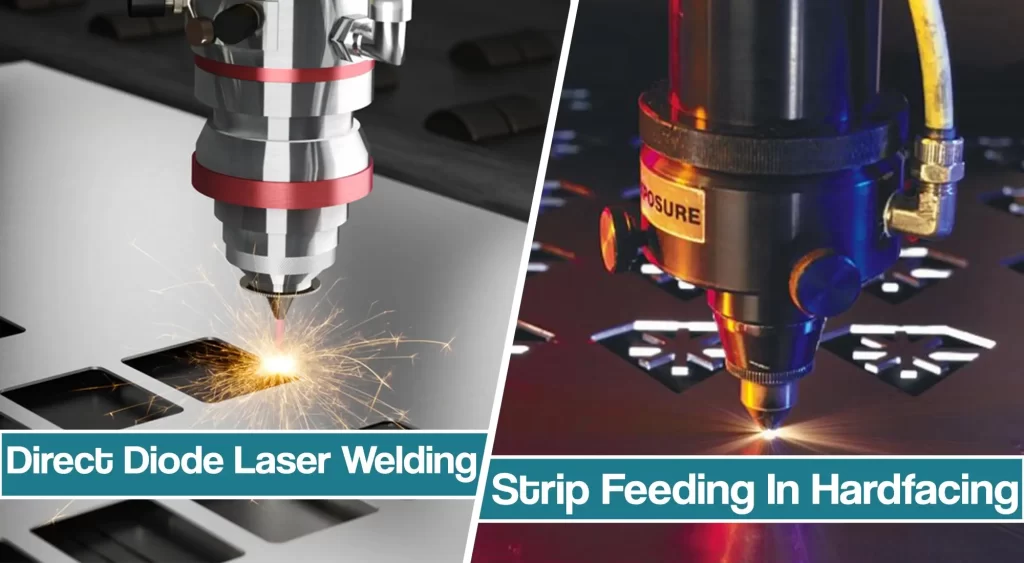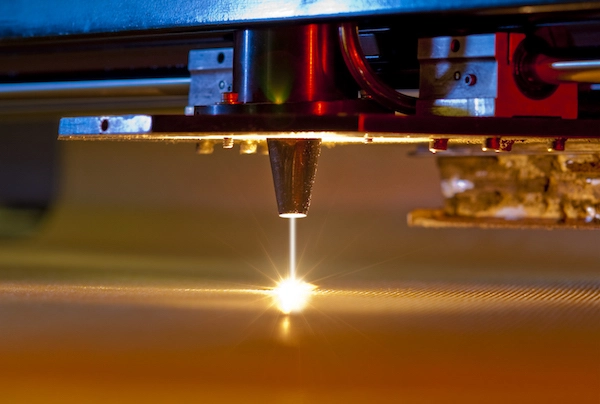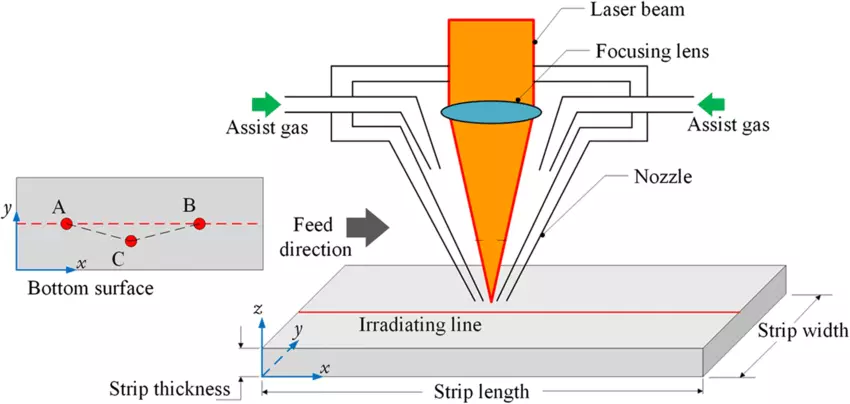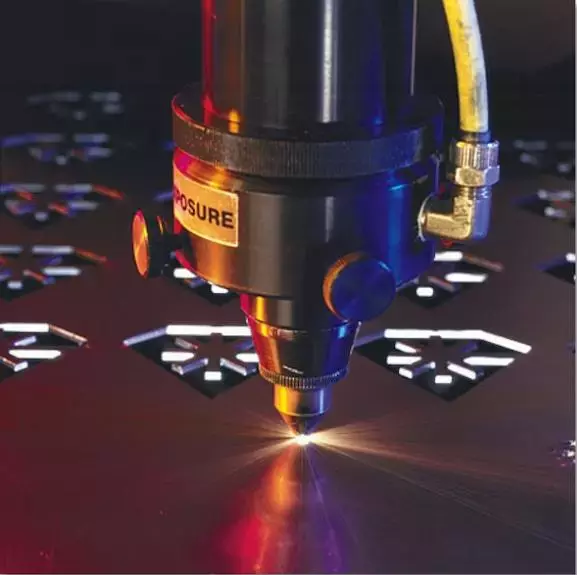In hardfacing, the strip filler metal is used for high productive deposition and low dilution with the base metal. Typically, strip filler is applied in an electric arc or electroslag hardfacing. Most research in the field of laser deposition is concentrated on powder feeding.
With direct diode laser deposition in hardfacing, the strip filler metal is used for high productive deposition and low dilution with the base metal.

Typically, strip filler is applied in an electric arc or electroslag hardfacing. Most research in the field of laser deposition is concentrated on powder feeding.
Advantages of Direct Diode Laser Welding
An average feed rate for a 4-5 kW CO2 laser beam welding is 18-20 g/min of Ni-alloy powders and as much as 100 g/min of Ni-Cr powder for a 6 kW diode laser. There was an attempt to deposit a layer of a Ni-base superalloy on a low-alloyed steel surface by melting a preplaced sheet with dimensions of 8 mm by 50 mm by 0.9 mm using a 10 kW, CO2 laser with a unique beam integrator to obtain a heat spot 10 mm by 10 mm. Deposits, made with a travel speed of 0.25-0.5 m/min, had a depth of penetration up to 3 mm.

The diode laser has a much better electrical efficiency than traditional lasers. Furthermore, a NUVONYX laser produces a heat spot characterized by a linear shape, with dimensions of 12 mm by 0.5 mm at an average focal distance. The lower power density and larger heat spot area made by a diode laser deposition result in minimal penetration of the base metal and a smooth deposit appearance.
In that case, the less concentrated heat source — the beam’s heat spot — retains a stable volume of the molten pool while penetration of the base metal is provided mainly by the molten pool’s enthalpy. The diode laser beam’s energy is high enough to melt thin wire — 0.9mm (0.035 inches) — and a metal strip with a cross-section four times larger. Experiments have verified that diode laser processing can achieve high deposition rates with strip feeding.
Process description
A High Power Direct Diode Laser, such as the NUVONYX – ISL-4000L, provided the output beam power of 4 kW to the workpiece installed at a focal distance of 3.74 inches below the laser head.
Process parameters: Strip feeding rate: 80-150cm/min. Travel speed: 10-20 cm/min. Shielding gas: Argon, 30 CFH. Strip: Nickel base super alloy 625, size: 6 mm by 0.413 mm (.236 by .016 inch).
Base metal: ASTM A36, 12 by 12 by 3/4 inch flat plates.
The direction of strip feeding was only across the laser beam’s heat spot, =90. Straight single and multi-layer beads were deposited to study the feasibility of the new process.

Results And Discussion
With strip feeding across the long axis of the beam, the molten metal was distributed evenly along with the beam’s heat spot. For example, for a strip cross-section of 6 mm by 0.413 mm, the following dimensions of the molten pool were obtained:
- Width: 12 mm to 14 mm.
- Height: 9 mm to 11 mm.
A proper ratio of strip feed rate to travel speed is required to achieve an even cross-section of the deposit. If the strip feed speed is insufficient for a given travel speed, the deposit has a lower height and an uneven shape.
To get a better formation of the deposit at a broader range of travel and strip feeding speeds, a change in orientation of the beam’s heat spot to the travel direction, angle “a,” is beneficial. In that case, the direction of the strip feeding to the beam heat spot (B = 90), but the width of the melted zone decreases, and an even bead can be formed at a lower strip feed rate or at a higher travel speed.
The flat surface of the strip absorbs the beam energy more effectively than the cylindrical surface of a wire so that the strip can be effectively heated and melted with wide clearance for feeding angles. In that case, the strip guide can be compact, and, with front and rear feeding, it increases the technological possibilities of laser deposition.
Front feeding of the strip
When the strip is fed ahead of the molten pool, the feeding direction is opposite to the travel direction. In that case, two different targeting points are available.
Orientation A
The strip enters inside the front part of the pool. Because the thickness of the molten pool in the direction of strip feeding does not exceed 2 mm to 3mm, strip melting/feeding has a limited feeding speed range. For a strip size of 6 mm by 0.413 mm, which was used in the experiments, a uniform-clad deposit was achieved at a strip feed speed of 80 cm to 140 cm/min. Therefore, the angle of the strip entering the molten pool and the location of occurrence of the strip melting are essential parameters.
Orientation B
The strip melts inside the laser beam above the molten pool. In this case, the molten metal is transferred to the molten pool by drops. Usually, one or two drops are formed simultaneously on the strip’s tip and flow to the pool. Those drops generate an oscillation of the pool, resulting in a solidified bead with fine ripples. The strip should be fed inside the molten pool to get an even bead. Because of the absence of the transfer of drops and the reduced oscillation of the pool, the bead has a smooth appearance.
With a higher strip feed speed, the bead cross-section becomes larger, reaching 20 mm 2 to 22 mm 2 at a feeding rate of 140 cm/min to 150 cm/min).

Penetration depth is very shallow and very uniform. The average penetration area for maximal beam power and a high feeding speed is 0.2 mm 2 to 0.4 mm 2, deviation: ±0.02 mm 2 . Bead cross-section changes with increasing travel speed. The bead becomes narrower and lower for strip feed speeds of 130 cm/min and 150 cm/min. A higher strip feed speed corresponds to a broader bead at the same travel speed. Therefore, higher strip feeding provides a larger bead cross-section.
Rear Feeding Of the Strip
It is possible to feed the strip from behind the laser beam. In that case, different targeting points for strip feeding are:
- C – The strip can be directed into the upper rear part of the molten pool at an angle to the horizon (y=10º to 15º), to provide a completed melting by the enthalpy of the pool.
- D – The strip can be directed to the laser beam above the molten pool (clearance: .035 inches to .08 inches (1 mm to 2mm) with drop transfer from the strip to the pool.
- E – The strip feeding can be oriented parallel to the pool’s upper surface, touching the pool on its way to the laser beam spot (no clearance between the strip and the pool).
Orientation C
When the strip immerges into the pool, it changes the temperature conditions in the pool and causes a crystallized front “pool-bead” to approach the strip because of heat sinking to cold bulk and the shadow effect. In that case, the strip can be welded (frozen) to the bead through an interruption of the deposition process, or it can push the liquid metal along the direction of travel, depending on the process parameters and the location of the targeting point concerning the laser beam. However, in experiments, we did not achieve an even formation of the bead with a C-orientation.
Orientation D
With the strip’s melt separated from the molten pool and drops transferred to the molten pool, the strip is melted by the laser beam and does not cause any problems for the formation of the pool. This orientation provides free conditions for the molten pool to solidify under the influence of the forces of surface tension.
Therefore, when the filler metal is too small for a given travel speed, the pool shrinks and forms a bead with a width that is only a portion of the fused zone. A similar effect was noticed with front strip feeding. When the strip melting rate is close to normal, the bead is characterized by an even shape with delicate ripples similar to front feeding.
Orientation E
When the strip touches the upper surface of the molten pool, the strip acts like sliding crystallization. It supports the liquid metal of the pool in the middle of the fused zone and provides smooth forming of the bead. For this strip orientation, beads with a smooth surface were formed at a wider range of process parameters and lower strip feed speeds.
When there was not enough molten metal to get an even deposit, a sliding strip provided the precise formation of the bead in the middle of the fused zone.

The deposit cross-section reached 20 mm2, similar to front feeding, with maximal strip melting nearing a 27 g/min rate.
The strip deposition process is very robust and requires minimal preliminary adjustment of the strip guide and minimal “on-the-fly” controlling. Each bead should be overlapped for deposition over a wide area by 20 percent to 30 percent to obtain a flat profile with a maximum width. Because of rapid cooling, it is possible to use this process to deposit on tilted surfaces and edges.
Samples cut from multi-layer beads were used for the next set of metallographic research.
Metallographic Investigation
Metallographic investigations of strip deposits reveal sound metal and the absence of defects. Multi-layer (8 layers) deposit has a dendrite microstructure with a direction corresponding to the direction of heat flow during cooling. There is no demarcation indication at the points at which the borders between the deposited layers are located. Grains are disoriented at the bottom of the area because of multidirectional heat sinking, and the grains are more directional in the upper area of the deposit. The heat-affected zone of the base metal has relatively large grains directly adjacent to the interface, and they become finer as one moves further into the base metal.
Due to the high cooling rate of the clad, diffusion of Fe from the base metal to the deposit through the interface is within a 200 m layer (Figure 12). The concentration of other alloying elements – Cr, Ni, and Mo – in the deposit decreases inside the layer, less than 300 m above the interface. There is no noticeable mutual diffusion across the interface.
A microhardness survey was conducted along the vertical line in the middle of the deposit at distances ±4000 m in both directions from the interface with 250 HK to 350 HK, at 100g for 10 seconds (Figure 13). Some increase in hardness of the base metal was observed near the interface. This was probably connected to the phenomena in the heat-affected zone.
Conclusion
Strip filler can be used with a direct diode laser to enhance the application and productivity of resurfacing. With a 4 kW laser, melting rates up to 3.72 cm3/min for nickel-base super alloy 625 can be achieved.
The laser deposition process became very stable with strip feeding across the heat spot’s long axis. Targeting the strip to the molten pool can be easily accomplished and controlled. Process provides minimal penetration of the base metal.
There are several possible orientations of the strip feeding direction to the beam’s heat spot and to the travel direction. This enlarges the application possibilities for the diode laser strip deposition.
Resources:
- High-Power, High-Brightness Direct-Diode Lasers, by Stephan Strohmaier, Christoph Tillkorn, Peter Olschowsky, and John Hostetler
- Direct diode lasers with comparable beam quality to fiber, CO2, and solid state lasers by Robin K. Huang, Bien Chann, James Burgess, Michael Kaiman, Robert Overman, John D. Glenn, Parviz Tayebati
- Direct diode lasers and their advantages for materials processing and other applications by Haro Fritsche, Fabio Ferrario, Ralf Koch, Bastian Kruschke, Ulrich Pahl, Silke Pflueger, Andreas Grohe, Wolfgang Gries, Florian Eibl, Stefanie Kohl, Michael Dobler






